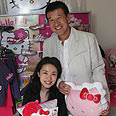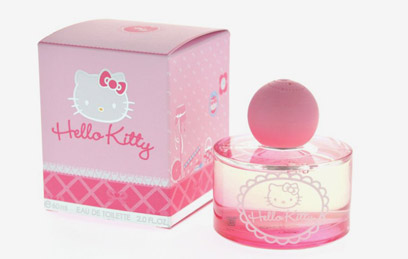
Hello Kitty making aliyah
Japanese fictional character, whose image has been used on 280,000 products in Europe, to officially land in Israel as part of new chain of stores
"You are one of the only countries which have survived the global financial crisis so well," says Roberto Lanzi, an Italian, president of Global Consumer Products for the EMEA market (Europe, Middle East, Africa) at Sanrio, the Japanese company which owns the Hello Kitty brand.
He made the remark during a visit to Israel with Kunihiko Tsuji, one of the company's owners. "Although you have the limitations of a small country, the Israeli market has great potential," the two agreed.
Hello Kitty, which has such a Western name, is in fact a Japanese cat. The products bearing its image have a sales turnover estimated at more than $6 billion a year.
Exactly how many products are marketed with the cat? Tsuji and Lanzi admit that they have no idea. In Europe alone they have approved the production of some 280,000 products in the past year. But Tsuji admits that a successful franchising business is a gold mine. "You basically don't produce anything," he smiles.
"The most profitable channels are the cell phone content and the video games, and in this category the biggest profits come from the consumer downloading content directly from the device's manufacturer. There the franchise fees reach 30-35%," reveals one of the captains of franchising in the world.
"When it comes to working with operators like Orange in your country, the franchising fees 'go down', but they are still relatively high compared to the other industries, standing at 18-20%."
37 years of meow
Sanrio was founded in 1960 by Shintaro Tsuji, Konihiko's father, as a company for gifts based on popular characters. Kitty joined the company's line of characters only in 1974. A year later its image appeared on the first product: A vinyl purse. Today Sanrio is the biggest greeting card company in Japan, operates two amusement parks, produces films and creates video games.
"Every year the company creates five to 10 new characters," says Tsuji. The graphic team and designers of the characters and products include hundreds of people, most of them in Japan, but also in the United States and Europe. Kitty is undoubtedly the company's biggest asset.
"For many years Japan was our key market, and I was responsible for exports. I decided to go with exports to minimize conflicts with my father, who views the world with Japanese eyes. In retrospect, our breakthrough abroad turned the brand into a success story, although it's important to say that Sanrio is not just about Kitty."
How was Hello Kitty created?
"I had a senior position in the company, managing the production of our sweets and fur dolls, when my father decided there was a need for such a character. The character was created by one of the designers. For more than 20 years Kitty wasn't our leading character - it was a rabbit called My Melody. At the time Kitty was red, while out other characters were in pastel colors.
"It made its breakthrough in 1995, when the designers were replaced and began painting it in pastel colors as well. At the same time we realized that changes must be made in the character itself. Kitty of the past had a big ribbon, and we began drawing it with flowers, as a hospital nurse and in many other jobs, and that proved to work."
"Kitty's uniqueness is in its simplicity – one line, few colors," Roberto Lanzi adds. "That's why it's suitable for children, youth and adults. It will never convey a negative message and will not be linked to violence or sex."

Hello Kitty perfume. Variety of products (Photo: Jimmy Richard)
Yoko, Tsuji's young and slim wife, joins the conversation. The smiling woman looks like a walking advertisement for the brand with merry Japanese chic – from the diamond necklace she is wearing, through her mobile phone embedded with pink and white Swarovski crystal stones in the image of the kitten, to the purse containing dozens of small souvenirs which she hands out to anyone expressing an interest or enthusiasm when it comes to Kitty, including the waitress in the meeting room we're sitting in.
When I wonder if she would agree to pose for a photo with the collection, she quickly runs into her room and returns dressed in a black shirt with silver sequins, of Kitty of course.
Kitty has no mouth, and that made it difficult for her to become part of TV shows, for example. Why doesn't she have a mouth?
"It stems from the Japanese thinking behind the character," says Tsuji. "When you ask a person where a certain street is, he'll answer you. But when he doesn't have a mouth, he'll take you by the hand and lead you to the destination. You use body language, which creates and conveys more warmth.
"The absence of a mouth creates a feeling of closeness, and leaves many people with the ability to give the character their own interpretation, although I can't remember who decided not to give Kitty a mouth. It happened too many years ago."
What are the strangest products people have asked to create with the kitten?
"There are numerous examples. A galabiya with diamonds sold for $1,500 in Dubai, contact lenses, teeth straightening devices. We recently received a request from a European fuel company to use packages bearing the character. In Europe there are fresh eggs with Kitty's image printed on them, smoked salmon packages, pasta, tomato paste. A new item is born almost every day."
The two show me an iPhone application for Muslims, requiring a subscription fee. It includes a prayer time alert, five times a day. Kitty plays the role of muezzin.
What were your most interesting experiences with the brand?
"Japan has a passenger plane called Hello Kitty. You can find Kitty on everything in it, even on the toilet paper. The flight attendants say they run out of toilet paper rolls every five minutes because people tear out pieces as a souvenir."
Was there anything that annoyed you?
"We're annoyed when the product is ugly or when the character is used for a product of bad quality. I was furious when the Taiwan police decided to use the character. Police officers caught committing offenses such as parking offenses are forced to wear ribbons with Kitty's image on their arms for several days. We really don't like that idea."
What products are not allowed to use the character?
"Cigarettes and lighters, apart for the Zippo silver lighter which is considered a collector's item."
In Japan of all places, where you have been holding the first place among animated characters for years, surveys conducted in the past two years have ranked you in the third place. After Anpanman, the star of the series produced by Nippon Television, and Pokémon, which is owned by Nintendo.
"Other characters have an age limit. The designated age groups they turn to are stronger. But we are the only ones with no age limit, and no one else has the variety we have."
Israeli connection
Israel was the first Hello Kitty frnachiser in the world, through the LDI company of Mapal Communications with CEO Yossi Fox, which serves as the character's franchiser to this day. In Israel Kitty is marketed on 200 products of local manufacturers, and is dominant in clothing and school accessories.
Additional products are introduced by international companies with international franchises. In the H&M chain, for example, Kitty is prominent in the lingerie department. The Inditex Group, which owns Zara, has an agreement in the lingerie department as well, although its products are not as prominent in Israel.
Sanrio has given the local franchiser the option to expand the use of the character. On the agenda: Credit cards (which already exist in worldwide). Mastercard has had a credit card with Kitty since 2004, and Visa added one in 2010. In the 1990s there was even an attempt to open a local Hello Kitty chain of stores, which was interrupted in its prime due to the franchiser's personal problem. The guests from Sanrio are planning to give this option another chance.
The brand has 350 stores in eight countries in the world, most of them in Japan, China, the US and Hong Kong. The products are sold also in the "store within a store" method in thousands of sales points, particularly in Japan and the US.
The stores are divided into two groups: "Regular" stores which present the brand's standard products in a wide variety of categories, and the Victoria Couture luxury stores, which sell clothing items, fashion accessories and jewelry. Sales points were recently opened in Casablanca, Dubai, Lebanon and Qatar. Tsuji is now working to develop the chain's stores in the world. Israel is the next stop.
Sanrio is contemplating which of the two formats would be suitable more for Israel. During their visit to Israel, Lanzi and Tsuji visited the Sarona compound in Tel Aviv and tried to decide whether the project matches luxury stores.
What next?
"Apart from expanding the chain of stores, we are branching out into the food industry. The Hello Kitty café chain is gaining momentum in Korea, Taiwan and Japan. We have already opened a restaurant in Hawaii. We plan to enter the automobile industry as well."
- Follow Ynetnews on Facebook










